Throughout time, the spider has been associated with many myths and legends. In mythology worldwide, the spider is prominently featured. Throughout Africa, Spider is either a trickster or a great god. Japanese believe that Spider Woman can ensnare careless travelers. In contrast, the Pueblo Nations of America believe that Spider Woman created the Universe. The Greeks and Norse looked upon Spiders as the Weavers of people’s fates and connecting the Past with the Future.
Christians see Spider Webs as traps. Like Flies, people become ensnared by vain works and become stuck fast in the webs. Spiders represent human fragility and the enticement of evil. However in Germany, Spider Webs are a part of Christmas tree decorations. According to folklore, Spider realized what glorious day was Christ’s birth. So She spun silver and gold webs on trees to show her faith and to glorify the Birth of the Lord. Many superstitions instruct people to never kill a Spider found in a house. The “house” spider is there to bring good luck and good fortune to the inhabitants.
Here are some of the ones I have gathered from the “Web” for your enjoyment and enlightenment!!
“If you wish to live and thrive, Let a spider run alive. ”
.. Old English nursery rhyme.
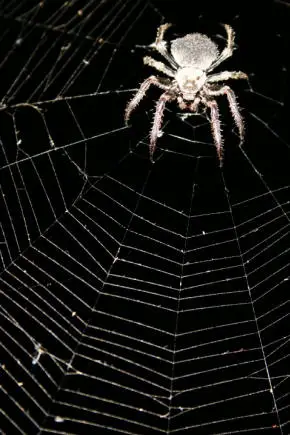
Table of Contents
SPIDER LEGENDS FROM AROUND THE WORLD
Germany: The legend of the Christmas Spider
Once upon a time, long ago, a gentle mother was busily cleaning the house for the most wonderful day of the year…. The day on which the Christ child came to bless the house. Not a speck of dust was left. Even the spiders had been banished from their cozy corner in the ceiling to avoid the housewife’s busy cleaning. They finally fled to the farthest corner of the attic.
T’was Christmas Eve at last! The tree was decorated and waiting for the children to see it. But the poor spiders were frantic, for they could not see the tree, nor be present for the Christ child’s visit. But the oldest and wisest spider suggested that perhaps they could peep through the crack in the door to see him. Silently they crept out of their attic, down the stairs, and across the floor to wait in the crack in the threshold. Suddenly, the door opened a wee bit and quickly the spiders scurried into the room. They must see the tree closely, since their eyes weren’t accustomed to the brightness of the room… so the crept all over the tree, up and down, over every branch and twig and saw every one of the pretty things. At last they satisfied themselves completely of the Christmas tree beauty.
But alas!! Everywhere they went they had left their webs, and when the little Christ child came to bless the house he was dismayed. He loved the little spiders, for they were God’s creatures too, but he knew the mother, who had trimmed the tree for the little children, wouldn’t feel the same, so He touched the webs and they all turned to sparkling, shimmering, silver and gold!
Ever since that time, we have hung tinsel on our Christmas trees, and according to the legend, it has been a custom to include a spider among the decorations on the tree.
A Ukranian Christmas Story: The Story of the Spider and the Christmas Tree
There once was a widow who lived in a cramped old hut. She lived with her children. Outside their home was a tall pine tree. From the tree dropped a pine cone that soon started to grow from the soil. The children were excited about the prospect of having a Christmas tree, and so they tended to it, ensuring that it would continue to grow and be strong until it became tall enough to be a Christmas tree to take inside their home. Unfortunately, the family was poor and even though they had a Christmas tree, they couldn’t afford to decorate it with ornaments for Christmas. And so on Christmas eve, the widow and her children went to bed knowing that they would have a bare Christmas tree on Christmas morning.
The spiders in the hut heard the sobs of the children and sad cries, and decided they would not leave the Christmas tree bare. So the spiders created beautiful webs on the Christmas tree, decorating it with elegant and beautiful silky patterns.
When the children woke up early on Christmas morning they were jumping for excitement. They went to their mother and woke her up. “Mother, you have to come see the Christmas tree. It’s so beautiful!”
As the mother woke and stood in front of the tree, she was truly amazed at the sight that lay before her eyes. One of the children opened up the window as the sun was shining. The sun would slide along the floor and slowly glide up the Christmas tree and onto the webs. As the rays of the sun shone on the tree, the webs turned into glittering silver and gold colour; making the Christmas tree dazzle and sparkle with a magical twinkle.
From that day forward the widow never felt poor, instead she was always grateful for all the wonderful gifts she already had in life.
Africa: Anansi
West Africa is the home of Anansi, a folk hero, who is both spider and man to the Ashanti people. He is a trickster, a provider of wisdom and a keeper of stories. His role is both light hearted and profound, often providing the link between people and the supreme being.
One of the stories is about Anansi’s involvement in the creation of the world. Anansi was ordered by the sky god to spin the fabric from which people would be made. Anansi then acted as the messenger between people and gods. Through Anansi’s skill as a messenger the sky god gave people day and night, rain and wind.
In another story, Anansi put all wisdom in a pot to keep it safe But the pot was so big he couldn’t carry it. When his son wisely suggested that he put the pot on his back, Anansi realised that all wisdom wasn’t in the pot. In a fit of temper he tipped the wisdom out of the pot. Now wisdom is available to all people.
Australian Museum Online.
Japan: The Legend of the Tsuchigumo – Sent in by Hana
The Tsuchigumo (translated as “Earth spider”) – A mythical, supernatural creature faced by many heroes throughout Asian legend. The term Tsuchgumo is also loosely used for bandits, untrustworthy shopkeepers, and thieves. The Tsuchigumo were said to live in caverns beneath the mountains and the Tsuchigumo in ancient legend were able to take the visage of a fairy-like boy or a woman of black spider coloured skin and white cobweb hair depending on the version of the story. In one specific tale a Traveller is said to have been lured to a house whilst on a search for a mythical, giant skull and was placed under a spell by a Tsuchigumo in the guise of a dark skinned pale haired young boy. However, the traveller breaks this spell by striking out at the boy with his sword after he suspects foul play. The traveller discovers the house is actually covered in spiders and completely constructed from web.
The strange boy flees the scene and after tracking down the boy, the traveller learns that he is actually a giant spider demon, or Tsuchigumo.
There is a conflict and the Tsuchigumo is wounded badly. He barters for his life with the traveller and begs forgiveness. “It is only my nature to set traps.” The Tsuchigumo pleads. “If you show me mercy I will save your own life thrice.” The traveller agrees to this deal and lets the Tsuchigumo live. Now the Boy-Tsuchigumo and the Traveller set out together to find the mythical giant skull.
Along the way they come across a Kitsune (A nine-tailed fox demon able to take human form) The Kitsune is intrigued by the fact that the traveller has managed to humble a Tsuchigumo. She agrees to help the Traveller find the skull. Her payment is the sheer joy of watching the young half spider humiliated and humbled by his human captor.
The trio travel far and wide across many lands, and through many dangers. Soon they come to a great ocean. The Tsuchigumo fears the ocean above all else. “Fish eat spiders, and away from the earth I will have no power. I need to touch the earth or I will grow sick and die.”
The Kitsune looked equally appalled. “I am a creature of fire, if the ocean should rise up and take me I will drown and be forever snuffed.”
The traveller however insisted they must cross the ocean to get to the island with the skull, and so he bade the Tsuchigumo to cross. Bound by his oath and always prideful of keeping his word the Tsuchigumo at last agreed. The Kitsune not one to miss such complete despair of the Tsuchigumo decided she too would brave the ocean.
The crew of the ship was very superstitious, so the young dark skinned boy, and the red haired girl were quickly hidden deep inside the ship. However, the crew had seen the female Kitsune, and had decided that she was a curse upon them. When the sea grew angry, and food ran short, they blamed the hidden girl.
Late in the night, the crew against captain’s orders decided to rid the ship of its accursed female. They crept into the quarters where the Traveler and his companions slept, and raised a knife to the Kitsune’s and the traveller’s throats. The Tsuchigumo moved quickly, as it was hiding up in the ceiling and had not been seen by the crew. The Tsuchigumo wrapped the murderers up in his webs before they could kill the traveller or the Kitsune. The Kitsune used her magic to charm the captured men and convinced them that they had been only dreaming. Then she sent them back up to their cabins.
“I have saved your life once,” the Tschigumo told the traveller weakly. “And as I have also saved the Kitsune’s Life. Now as payment Kitsune must promise to save mine in turn.”
They arrived at the island, and disembarked the ship. The Kitsune moved quickly ahead and discovered that the skull was in the possession of the Yokai of the volcano. It was then that the Traveller was captured by the Yokai as the poor Tsuchigumo was trying to regain his strength after the long tiresome voyage. The Kitsune quickly moved to help the Traveller, and was also taken hostage by the powerful native Yokai.
Both were taken to the cave of the Ushi-oni. (One of the most fearsome and formidable of yōkai is the oceanic ushi-oni, an enormous and bloodthirsty beast usually drawn with a horned head like a bull, the teeth of a lion, venomous fangs like a snake, the pinchers of a giant crab and a body like a gigantic spider.)
The Ushi-oni hungry and angered by the intruders declared that he would eat them both alive. Immune to the fire of the Kitsune the Ushi-oni laughed at her and hung her up with its webs to eat later. The traveller was about to be eaten when the brave and loyal Tschigumo arrived. He declared that the traveller was his, and that as a fellow spider demon the Ushi-oni had to respect his claim and retain his honour.
The Ushi-oni had no respect or honour, but was intrigued that such a small and young male Tsuchigumo would brave a voyage from it’s native mountain home far east of the island, and dare to stand against a much more powerful spider demon. He also knew that an Earth Spider was much weaker then a plate armoured Water Spider. He accepted a trio of challenges, one to be set by the traveller; one decided by him self, and one chosen by the spirit of the volcano. If the Tsuchigumo won, he would acquire 3 prizes. If the Ushi-oni won, he would gain 3 prizes.
The first challenge was what the Traveller deemed the Tsuchigumo’s strongest talent. Weaving. The Tsuchigumo indeed was much more talented in weaving then the bulky water spider. He spun a magnificent web and was named the 1st challenge victor.
The second challenge set by the Ushi-oni was brute strength. In this he excelled, and he easily was able to prove himself the victor.
The spirit of the volcano declared the final challenge as one of cunning and wit. Both spiders would have to prove their worth with the best sacrifice for the volcano.
The Ushi-oni declared to the volcano that he would sacrifice all of the Yokai on the island to her. He then trapped all the yokai and sent them shrieking into her belly.
The Tsuchigumo waited patiently while the Ushi-oni exhausted himself at gathering all of the monsters on the island to feed to the volcano. When he had dropped the last monster into the volcano the Tsuchigumo then pushed the Ushi-oni into the volcano. “I give you my enemies, which include the Yokai and the Ushi-oni.” The volcano spirit conceded that indeed the Tsuchigumo had proven to be the most cunning. Then asked what his 3 prizes would be. Ever loyal and wise the Tsuchigumo stated that his prizes would be The Traveler, The Kitsune, and the giant skull.
With the skull in hand, the traveller returned to the ship with his two companions. He declared that the Tsuchigumo had saved his life twice. The Kitsune also agreed to have been saved twice, so this time she agreed to give her ability to resist fire to the Tsuchigumo as payment for the second rescue.
On the ride back, the Tsuchigumo grew very ill. Having travelled once across the ocean had been rough; the return trip was proving even worse. Unable to retain his humanoid form the Tschigumo was discovered by the crew for what he was. They declared that he must be killed as he is an evil demon. Unable to defend himself, the Tsuchigumo was dragged onto the deck and beaten severely by the enraged crew. The traveller was dragged to the deck and was questioned about his affiliation with such an evil spirit. That he was in fact a lord of hell and should be immediately put to death. The Kitsune was horrified and unable to help as she too was overpowered and questioned.
Then the Loyal and true Tsuchigumo spoke out. “I am the cause of this villainy. I have manipulated and tricked the Traveller.” He spoke truth because he had tricked the traveller into his house back in the mountains.
The crew agreed that the Tsuchigumo was able to manipulate men, and so declared that he should be cast into the sea for his evil sins. As they untied the traveller and released him from their hatred, the traveller looked sadly upon the Tsuchigumo. “You have spared my life thrice, and as such I break you of your contract with me.”
The Tsuchigumo did not struggle as the crew threw him over the side, and the Crew only cheered as the creature was pulled under the sea by the angry waves.
The quick thinking Kitsune slipped away from the sight of the jeering crew and freed a wooden boat from the side of the ship. She rushed the life boat to the Tsuchigumo’s aide. The Kitsune pulled the weak and now half dead Spider onto the lifeboat, just as the crew started to volley burning arrows at the two demons. Both spider and fox now immune to fire, and Spider who was an earth spirit extended his magic to the very wood then drifted off to sea safely away from the men, the boat, and the traveller.
After boat landed on a distant shore, the Kitsune exhausted from the experience declared that she had repaid the Tsuchigumo for his saving her life, and now would be on her way as the Traveller was no-longer in control of the Tsuchigumo and thus he was no longer any fun to her.
It is said that any traveller who to this day shows sympathy to a Tsuchigumo in need will be saved from death thrice. It is also said that after the adventure the gods smiled down on the Tsuchigumo and made the spider the symbol for Wisdom, labour, cunning, and prudence.
Australia: Aboriginal Spider Tradition
Spiders are an important Burnungku clan totem for the Rembarrnga/Kyne people in central Arnhem Land. Spiders in their webs are associated with a sacred rock on the clan estate and the design is connected with a major regional ceremony. These spider totems provide a link with neighbouring clans who also use spider totems in their rituals.
Australian Museum Online.
Germany: Christmas Legend
If you’ve ever gazed at the beautiful tinsel sparkling on your Christmas Tree and wondered who came up with idea of decorating the tree in this way, wonder no longer. According to German legend, it signifies a Christmas miracle from many years ago.
The day before Christmas, as the small house in Germany underwent its Christmas Eve cleaning, the resident spiders, not wanting to be swept up with the broom, hid in the attic. When nightfall came and all were settled into bed, the spiders crept downstairs. To their amazement, in the middle of the living room was a beautifully decorated Christmas Tree. They were so excited that they ran all over the tree.
They scurried up the trunk and leapt from branch to branch. Unfortunately they had left their mark. A gray spider web now covered the whole tree. When Weihnachtsmann, also known as Father Christmas, arrived he was amused to see the tree covered in spider webs. Now he faced a dilemma. The family would be disappointed to see their beautiful tree all wrapped in the webs, but the spiders were so pleased with their handiwork that he did not have the heart to take it down. What could he do?
He thought and thought and came up with a wonderful solution. He turned all the webs into beautiful shimmering silver strands. When the family awoke on Christmas Morning they ran to the living room and saw their tree sparking and glittering in the morning sun. Their delight was unsurpassed. They had never seen such a beautiful tree. Only the mother knew that a true Christmas miracle had occurred overnight.
From that day on tinsel became a treasured ornament for trees all over the world. Those who know the legend make sure that they give thanks to the industrious spiders by hanging a beautiful silver or gold spider ornament in a prominent location on their tree.
from Michele
USA: Why a Spider has Eight Eyes
When Earthmaker had completed his creation of the world, he looked for a creature that could watch over his creation. First Earthmaker appointed Turtle to oversee things, but his legs were so stubby that he could not see very far at all. So he was recalled.
Then Earthmaker appointed Kaghiga (Crow/Raven) to oversee the world. Kaghiga could see far and wide, but he did more than just watch: he gave orders to everyone, and never was he silent for even a moment.
Thus Earthmaker recalled Kaghiga. Then Earthmaker appointed Bear. Bear could stand on his hind legs and see well and could even climb trees so that he could see in every direction. However, Bear had a terrible temper, and soon frightened the whole of creation. So Earthmaker recalled him as well.
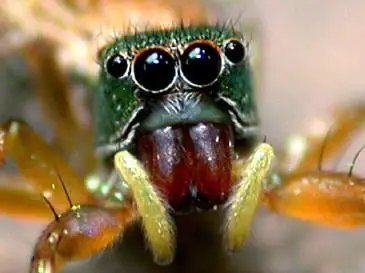
Then Earthmaker appointed Spider to watch over the world. Spider was without any passion, so no one feared her. Her voice was so small that only Earthmaker himself could hear her. Because she could climb, Spider was able to see far and wide. In the beginning, Spider had only two eyes like everyone else, but just to make sure that she could see everywhere, Earthmaker gave her six new eyes, one eye for each direction. Ever since, spiders have had eight eyes.
by Joi StCyr
David Lee Smith, Folklore of the Winnebago Tribe (Norman: University of Oklahoma Press, 1997) 96
SPIDERS IN HISTORY AND RELIGION
David:
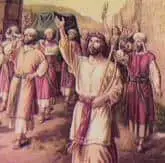
Approximately 3060 years ago David was being pursued by King Saul when he hid in a cave near Jerusalem. A spider made its web across the opening. When Saul saw the web, he called his men away, saying that it was useless to search the cave because the web showed that no one could have entered. So David’s life was saved and he lived on to become King of Israel.
Mohammed:
Fourteen hundred years ago the prophet Mohammed was being chased by his enemies near Mecca when he hid in a cave. Miraculously, an acacia tree sprang up out of the ground in front of the cave. A wood-pigeon nested in the tree and a spider made its web between the cave entrance and the tree. As a result his enemies overlooked the cave and Mohammed escaped to become the Prophet of Islam.
Yoritomo:
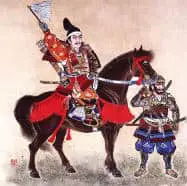
Eight hundred years ago Yoritomo, a warrior from Japanese mythology, was running from his enemies after a defeat in battle when he hid inside a large hollow tree. While he was hiding, a spider built a web across the opening. When his enemies found the hollow tree, they were convinced that Yoritomo was not inside because of the web. Yoritomo escaped to become a shogun (an important military leader).
Robert the Bruce:

In 1306, Robert the Bruce and his army had been fighting against King Edward I of England for control of Scotland. Robert was lying exhausted in a barn when he noticed a spider try to fix its web to a beam six times. On its seventh attempt, the spider succeeded. Robert was inspired, saying,
“Now shall this spider teach me what I am to do, for I also have failed six times.”
He then gathered together some more followers and they won the next battle. After a successful campaign they eventually defeated Edward’s army in 1319.
Australian Museum Online.
Tarantulas: Why the tarantula has a bad name:
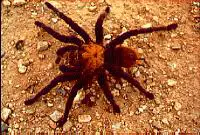
In 1370, in a small town called Taranto in southern Italy a strange and mysterious epidemic broke out for which the only cure seemed to be wild dancing and music. Occurring every summer for three hundred years, this disease was thought to be caused by the bite of a large, hairy Wolf Spider (Lycosa tarantula), which became known as a Tarantula.
In the 1600s, people discovered that these spiders were virtually harmless. Many then concluded that the whole phenomenon of Tarantism was simply an excuse far a wild party. However, it is now suspected that a spider was involved and the real culprit was a European relative of the Redback or Widow Spider.
As Europeans colonised the world, they saw even bigger and hairier spiders, and called them Tarantulas too. As a result, many large and hairy spiders are now commonly, but incorrectly, called Tarantulas.
Australian Museum Online
Arachne: The Legend of Arachne
The name science uses for spiders, ‘arachnid’, is derived from a Greek myth outlined in the following story.
Long ago in a village on the plain below Mount Olympus lived a beautiful maiden named Arachne. She devoted her days to weaving and embroidering, and such was her skill that even the nymphs from the woods crept out and gazed with awe at the wonderful pictures she wove. Unfortunately, Arachne was admired but never loved, as she boasted endlessly about her own skill and deftness.
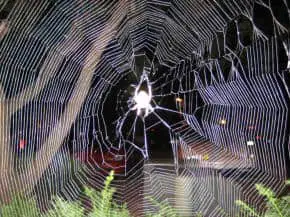
She was so sure of her skills that she boasted that not even Athene, the goddess of wisdom and patroness of arts could rival her work.
Athene was so incensed by these taunts that she visited Arachne, disguised as an old woman, and warned her against incurring the wrath of the gods. Arachne dismissed the warning and claimed if ever she met Athene she would challenge her to a contest. Athene threw off her cloak and accepted the challenge.
Athene chose for her tapestry her own contest with Neptune while Arachne chose the abduction of Europa. As their labours finished, each turned to see the other’s work- while Arachne’s tapestry was wonderful, one glance at Athene’s work sufficed to show that Arachne was beaten.
In despair, Arachne tried to hang herself in her own tapestry; however, Athene was unwilling for her rival to escape so easily and changed her suspended body into a misshapen and repulsive form and condemned her to continue weaving throughout the ages.
Apache Creation Legend – An Apache Legend:
In the beginning nothing existed: no Earth, no Sky, no Sun, no Moon. Only darkness was everywhere. Suddenly from the darkness emerged a thin disc, one side yellow and the other side white, appearing suspended in midair. Within the disc sat a small bearded man, Creator, the One Who Lives Above. As if waking from a long nap, he rubbed his eyes and face with both hands. When he looked into the endless darkness, light appeared above. He looked down and it became a sea of light. To the East, he created yellow streaks of dawn. To the West, tints of many colors appeared everywhere. There were also clouds of different colors. Creator wiped his sweating face and rubbed his hands together, thrusting them downward. Behold! A shining cloud upon which sat a little girl.
“Stand up and tell me where are you going,” said Creator. But she did not reply. He rubbed his eyes again and offered his right hand to the Girl-Without- Parents.
“Where did you come from?” she asked, grasping his hand.”From the East where it is now light,” he replied, stepping upon her cloud.
“Where is the Earth?” she asked.
“Where is the sky?” he asked, and sang, “I am thinking, thinking, thinking what I shall create next.” He sang four times, which was the magic number.
Creator brushed his face with his hands, rubbed them together, then flung them wide open! Before them stood Sun-God. Again Creator rubbed his sweaty brow and from his hands dropped Small-Boy. Creator, Sun-God, Girl-Without-Parents, and Small-Boy sat in deep thought upon the small cloud.
“What shall we make next?” asked Creator. “This cloud is much too small for us to live upon.”
Then he created Tarantula, Big Dipper, Wind, Lightning-Maker, and some Western clouds in which to house Lightning-Rumbler, which he just finished. Creator sang, “Let us make Earth. I am thinking of the Earth, Earth, Earth; I am thinking of the Earth,” he sang four times.
All four gods shook hands. In doing so, their sweat mixed together and Creator rubbed his palms, from which fell a small round, brown ball, not much larger than a bean. Creator kicked it, and it expanded. Girl-Without-Parents kicked the ball, and it enlarged more. Sun-God and Small-Boy took turns giving it hard kicks, and each time the ball expanded. Creator told Wind to go inside the ball and to blow it up.
Tarantula spun a black cord and, attaching it to the ball, crawled away fast to the East, pulling on the cord with all his strength. Tarantula repeated with a blue cord to the South, a yellow cord to the West, and a white cord to the North. With mighty pulls in each direction, the brown ball stretched to immeasurable size–it became the Earth! No hills, mountains, or rivers were visible; only smooth, treeless, brown plains appeared. Creator scratched his chest and rubbed his fingers together and there appeared Hummingbird.
“Fly North, South, East, and West and tell us what you see,” said Creator.
“All is well,” reported Hummingbird upon his return. “The Earth is most beautiful, with water on the West side.”
But the Earth kept rolling and dancing up and down. So Creator made four giant posts–black, blue, yellow, and white to support the Earth. Wind carried the four posts, placing them beneath the four cardinal points of the Earth. The Earth sat still.
Creator sang, “World is now made and now sits still,” which he repeated four times.
Then he began a song about the sky. None existed, but he thought there should be one. After singing about it four times, twenty- eight people appeared to help make a sky above the Earth. Creator chanted about making chiefs for the Earth and sky. He sent Lightning-Maker to encircle the world, and he returned with three uncouth creatures, two girls and a boy found in a turquoise shell. They had no eyes, ears, hair, mouths, noses, or teeth. They had arms and legs, but no fingers or toes. Sun-God sent for Fly to come and build a sweat house. Girl-Without-Parents covered it with four heavy clouds. In front of the East doorway she placed a soft, red cloud for a foot-blanket to be used after the sweat. Four stones were heated by the fire inside the sweat house. The three uncouth creatures were placed inside. The others sang songs of healing on the outside, until it was time for the sweat to be finished. Out came the three strangers who stood upon the magic red cloud-blanket. Creator then shook his hands toward them, giving each one fingers, toes, mouths, eyes, ears, noses and hair. Creator named the boy, Sky-Boy, to be chief of the Sky-People. One girl he named Earth-Daughter, to take charge of the Earth and its crops. The other girl he named Pollen-Girl, and gave her charge of health care for all Earth- People.
Since the Earth was flat and barren, Creator thought it fun to create animals, birds, trees, and a hill. He sent Pigeon to see how the world looked. Four days later, he returned and reported, “All is beautiful around the world. But four days from now, the water on the other side of the Earth will rise and cause a mighty flood.” Creator made a very tall pinion tree. Girl-Without-Parents covered the tree framework with pinion gum, creating a large, tight ball. In four days, the flood occurred. Creator went up on a cloud, taking his twenty-eight helpers with him. Girl-Without-Parents put the others into the large, hollow ball, closing it tight at the top.
In twelve days, the water receded, leaving the float-ball high on a hilltop. The rushing floodwater changed the plains into mountains, hills, valleys, and rivers. Girl-Without-Parents led the gods out from the float-ball onto the new Earth. She took them upon her cloud, drifting upward until they met Creator with his helpers, who had completed their work making the sky during the flood time on Earth. Together the two clouds descended to a valley below. There, Girl-Without- Parents gathered everyone together to listen to Creator.
“I am planning to leave you,” he said. “I wish each of you to do your best toward making a perfect, happy world.
“You, Lightning-Rumbler, shall have charge of clouds and water.
“You, Sky-Boy, look after all Sky-People.
“You, Earth-Daughter, take charge of all crops and Earth-People.
“You, Pollen-Girl, care for their health and guide them.
“You, Girl-Without-Parents, I leave you in charge over all.”
Creator then turned toward Girl-Without-Parents and together they rubbed their legs with their hands and quickly cast them forcefully downward. Immediately between them arose a great pile of wood, over which Creator waved a hand, creating fire. Great billowy clouds of smoke at once drifted skyward. Into this cloud, Creator disappeared. The other gods followed him in other clouds of smoke, leaving the twenty-eight workers to people the Earth. Sun-God went East to live and travel with the Sun. Girl-Without-Parents departed Westward to live on the far horizon. Small-Boy and Pollen-Girl made cloud homes in the South. Big Dipper can still be seen in the Northern sky at night, a reliable guide to all.

